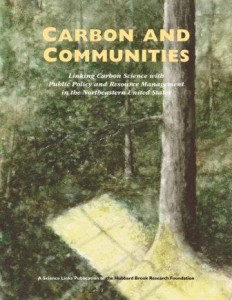
The Hubbard Brook Research Foundation’s Science Links Carbon Project was designed to help communities better understand their local carbon dynamics so they can take steps to reduce carbon dioxide emissions. Using carbon budgets synthesized from nine representative northeastern counties, a team of scientists at Hubbard Brook has partnered with other nonprofit organizations to summarize the best available information to assist county planners, municipal agencies, and local governments make land-use decisions and other policies intended to reduce carbon emissions. This website provides an overview of mitigation strategies, links to practical resources, a synthesis of recent forest carbon science, and policy recommendations tailored for the northeastern and Mid-Atlantic states.
View and/or download Carbon and Communities report here.
Communities are increasingly interested in addressing climate change at the local level, but people can only tackle climate change effectively if they have the ability to compare the cost and effectiveness of different carbon mitigation strategies over time. Few tools have been developed to analyze the climate change implications for local planning decisions on key issues such as development densities, land use, transportation, and alternative energy sources. HBRF’s carbon project provides analytical tools, accompanied by scientific information, which can contribute to the development of public policies to reduce net carbon dioxide emissions at the local scale.
Led by Dr. Timothy Fahey, a HBRF Trustee from Cornell University, a team of 19 scientists has worked on three distinct project phases. The team completed carbon budgets for nine counties in the Northeast that represent different land-use patterns and development pressures. Included in each case study is information on the main sources and sinks for carbon; the current carbon balances; the magnitude of potential future changes to the county’s carbon budget; and possible mitigation strategies and associated costs to address emissions.

Measuring trees at the Hubbard Brook Experimental Forest
County Case Studies for Science Links Carbon Project:
scientists in forest
Measuring trees at the Hubbard Brook Experimental Forest
1) Non-industrial forested (Grafton County, NH)
2) Industrial forest (Coos County, NH)
3) Mixed agriculture/forest (Tompkins County, NY)
4) Small urban/suburban (Chittenden County, VT)
5) Suburban (Baltimore County, MD)
6) Urban (Baltimore City, MD)
7) Post-agricultural forest (Worcester County, MA)
8) Exurban/Watershed/estuary (Essex County, MA)
9) Exurban/Watershed/estuary (Middlesex, County, MA)
Peer-reviewed scientific articles are being prepared using information from each of the case studies.
The results are contained in the report, Carbon and Communities, which is “translated” for the general public to help communities move toward carbon-based decision-making at the local level.
Support for the Carbon Science Links Project comes from the Jessie B. Cox Charitable Trust, Merck Family Fund, Sudbury Foundation, Orchard Foundation, Robert and Patricia Switzer Foundation, and the Northeastern States Research Cooperative.
